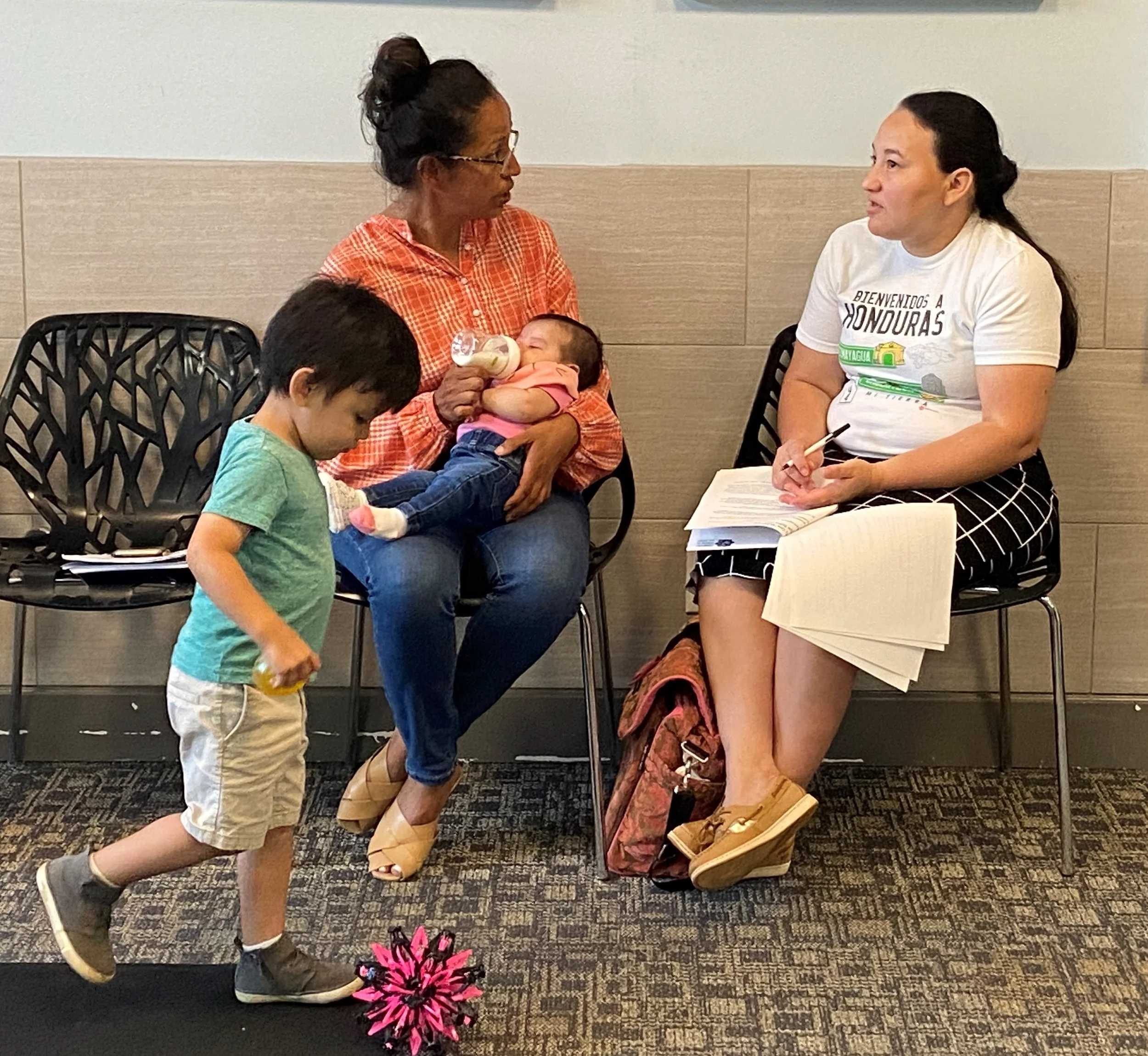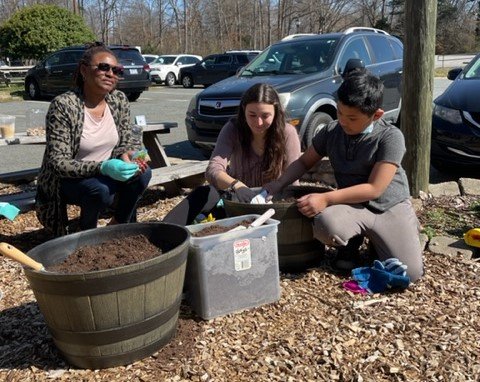Implementation Description
Community School of Davidson (CSD) historically has served a large special education population, but in recent years has worked intentionally to increase the percentage of economically disadvantaged (ED) students served as well. In the past, the school identified and addressed students’ individual needs as they arose, but as the range and frequency of unmet needs has increased, CSD’s leadership team opted to move from a case-based approach to a more holistic and efficient effort to assess the comprehensive needs of the children (and their families) while maintaining an individualized approach to serving students and their families. As part of this effort, the school established a Comprehensive Care Team (CCT) to manage comprehensive wrap-around services for students and families. The goal of the CCT is to build trust and strong relationships with families, while simplifying the communication loop families can rely upon to access the support they need. The team is structured with a case load approach so that families can quickly build one strong relationship immediately upon entering the school so they feel welcomed and comfortable as they build strong relationships with more and more staff over time. The approach takes into account the understanding that many caregivers have educational trauma of their own as they work to support their children in school so it is critical to help heal that trauma and build a positive school/home connection that helps parents feel valued, respected, and empowered in this partnership.
The CCT team consists of staff with responsibilities across the spectrum including transportation, nursing, ESL, administration, and social work. To organize their work, the team documented the range of needs once addressed on a case by case basis. Then the team developed a package of services which can be made available to an entire family and can be managed by a single school contact person or case manager. Case management assignments reflect existing relationships and for new families will develop depending on the primary type of support the family may need. For example, a family that requires translation support would be assigned a bilingual case manager. Each case manager carries a caseload of ten to fifteen families and leverages assistance from additional team members, such as the school psychologist, social worker, or nurse, as needed. Because members of the CCT are strategically positioned as eleven-month employees, summer break can be utilized by families and case managers to connect proactively and identify potential needs before the school year begins. The goal is to ensure that students are set up for success by starting the school year with the materials, devices, and resources they need, rather than waiting until the need triggers a crisis.
One key area assessed by the CCT is digital access for students and for their families. As the team works with families, staff members actively evaluate the reliability of home connectivity as well as family members’ confidence as technology users. CSD services include personal device loaners, hotspots, and access to subsidized home Internet connections, but just as importantly help desk sessions. Within school buildings, CSD has upgraded the availability of charging stations, guest network access, and more versatile and adaptable, secure storage for school-owned devices. CSD’s technology team is working with the CCT to implement replacement cycles, ensure that technology infrastructure keeps pace with evolving needs, and expand cyber security initiatives to protect the network as well as individual users.
Results
While the data supports the notion that CSD has low disciplinary actions due to our comprehensive support structures, holistic approaches, individualized instruction and academic support, the real Success of our comprehensive care team approach is best demonstrated in the stories of students whose lives are being changed as a result of the team’s work. Below are just a few examples.
First Generation College Student
During the 2020-21 school year, the team identified a newly enrolled family who relied on its high school senior as the family’s interpreter and primary caregiver to younger siblings and relatives. A high school administrator (who is also a licensed counselor) connected with the family, as the case manager for this family, when they first entered CSD. They became close very quickly and the administrator was able to rapidly put support in place for the family in multiple instances as she identified struggles. The CCT liaison was also able to support this senior throughout her college application journey. The student was admitted to Appalachian State as a first generation college student, but remained very concerned about leaving home to attend school. She felt a strong sense of responsibility to be available to continue supporting her family and ensure that her siblings could be as successful as she had been in high school. The Administrator/CCT Liaison, building on the trust she’d developed with the student and her family throughout the year, helped put a more sustainable plan in place for ongoing interpretation services, academic support, and access to other wrap-around services. In doing so she offered the student a more confident way to depart for her college experience, knowing school staff would stay connected to her family and respond to its needs as they arose. In addition, she was able to connect the student (as a new first year college student) with some CSD alum and App staff who could quickly help build a support system for her on the college campus as she entered college, helping to ensure a positive and successful transition to college.
Support for Non-Verbal Student and Family
During the hybrid learning period required by the COVID outbreak, CSD teachers reported concerns for a student whose grandparents had stepped in as guardians after the child and his siblings experienced extensive trauma early in their lives. The team assessed the family’s needs and crafted a plan for in-person instruction to support both the student’s and his caregivers, including referrals for medical interventions and the addition of nature therapy and a one-on-one assistant for the child. This child, and his siblings, participated in the summer bridge program. He has made extensive gains in all areas of development. The team continues to work with the family and the student and teachers have reported positive changes in classroom outcomes as he receives the interventional support he needs.
Challenges
The biggest challenge to introducing the CCT was, not surprisingly, in absorbing its impact on the school’s budget. New costs included adding several positions including additional counseling, EC, academic intervention, and family support personnel.
Future Modifications
As with most new programs and services, the CCT will continue to evolve and change to reflect the needs of CSD’s students and families. Those changes will be driven by the team’s experience, data and trends that help signal new areas of need, and grant opportunities as they arise to help fund added capacity and scope to support the team’s activities.
CritiCal Components
Getting Started
CSD administrators noted that a critical aspect in successfully serving children, no matter the depth or dimension of their needs, or the needs of their families, is building a strong school community. To that end, the leadership team is transparent with families and staff about its goals for broadening access to enrollment as a means not only of strengthening public education, but also in adding dimension to every student’s learning and growing experience. Children who learn in a community that includes a range of family experience, background, and resources develop empathy, perspective, and shared respect for the differences among us (The Century Foundation, 2019). By making the range of school wrap-around services available to all families CSD is consciously working against the tendency to label children by need, but rather establishing a baseline that positions every child for success.
Ongoing Supports
CSD administrators noted that the strength of the CCT is in the diversity of the skill sets its members bring to the table and the shared commitment to putting the children and their individual needs at the center of all decisions made.
CSD is committed to maintaining a CCT, but recognizes that the cost of a comprehensive support system has a significant impact on the bottom line of the school budget, so they continue to seek additional grants and donations to supplement their limited funding and ensure the longevity of this program. It is their sincere hope that per pupil educational ADM and EC funding continues to increase in future years
Equity Connections
“In 2019, approximately 11.6 million children under age 18 were in families living in poverty” (National Center for Education Statistics, 2022). These statistics mean that about one in every six school-age children in the US lives in poverty, with North Carolina ranking slightly higher than the national average. Unfortunately, these students often enter school behind their peers and with less resources to catch up. Having a school staff member who serves as a champion for the families in need is one of the best strategies for equitable family engagement (Jacques, 2018). Research shows that personal contact with families increases the connection with families and leads to improved academic outcomes for students (Ferguson, 2005; District of Columbia Public Schools, n.d.). Earning the trust of families takes time and intentionality, especially with historically marginalized populations, but once established student outcomes improve (Brewster, C. & Railsback, 2003).
Research
1. Brewster, C. & Railsback, J. (2003). “Building Trust with Schools and Diverse Families”. Adolescent Literacy. Northwest Regional Educational Laboratory. Accessed on June 18, 2021. Retrieved from http://www.adlit.org/article/21522/
2. District of Columbia Public Schools. (n.d.). Family engagement [Webpage]. Retrieved from https://dcps.dc.gov/node/994252
3. Ferguson, C. (2005). Reaching out to diverse populations: What can schools do to foster family school connections? Austin, TX: SEDL, National Center for Family and Community Connections with Schools. Retrieved from http://www.sedl.org/connections/resources/rb/rb5-diverse.pdf
4. Jacques, C & Villegas, A. (2018) “Strategies for Equitable Family Engagement” State Support Network. Washington, DC. Accessed on May 23, 2022. Retrieved from https://oese.ed.gov/files/2020/10/equitable_family_engag_508.pdf
5. National Center for Education Statistics. (2022). Characteristics of Children’s Families. Condition of Education. U.S. Department of Education, Institute of Education Sciences. Retrieved from https://nces.ed.gov/programs/coe/indicator/cce.
6. The Century Foundation. (April 29, 2019). “The Benefits of Socioeconomically and Racially Integrated Schools and Classrooms”. Accessed on June 25, 2021. Retrieved from https://tcf.org/content/facts/the-benefits-of-socioeconomically-and-racially-integrated-schools-and-classrooms/?session=1
7. United States Census Bureau. “Quick Facts North Carolina”. Retrieved from https://www.census.gov/quickfacts/fact/table/NC/PST045219
Click on the links below to learn more about this school and to download the complete Best Practice Implementation Strategy.




